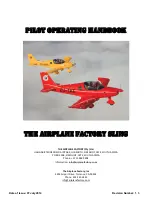
F
F
L
L
I
I
G
G
H
H
T
T
T
T
R
R
A
A
I
I
N
N
I
I
N
N
G
G
S
S
U
U
P
P
P
P
L
L
E
E
M
M
E
E
N
N
T
T
for SPORT
STAR
Light Sport Aircraft
Document No.: S2006FTSUS Revision: -
Date of Issue: 15/01/2006
Page:
90/130
4.13 Descent
4.13.1 Straight
Descent
Flight
If you descending straight then the descent angle depends on the entry
altitude at which you begin the descent, the level off altitude at which you
terminate the descent and how fast you want to descend. According to
these factors, you should adjust the angle of descent, airspeed and power
setting. If you descend at idle power setting with the throttle level fully back,
then you can descend even up to the never exceed speed VNE 146 KIAS,
270 km/h, 168 mph (marked by the red line on the airspeed indicator).
However, consider that the engine will be cooled very quickly and its
temperatures (oil and CHT) will decrease. It is possible that if the engine is
allowed to overcool like this all the way to the airport and then a Balked
Landing Procedure is carried out, the engine may not respond immediately
and may not reach full power when required. As well engine lubrication is
worse at low oil temperatures. Therefore a long descent at idle is not
recommended but a descent at a slightly increased idle.
When selecting the airspeed to descend at, the turbulence should be taken
into consideration. In smooth air the descent speed can be much faster
than in turbulent air. In turbulent air it is recommended to reduce the
airspeed. The angle of descent cab be adjusted by pulling or pushing the
control stick to reach the desired airspeed and then trim the airplane
longitudinally (especially in a long term descent). The forces on the control
stick in the Sportstar are relatively light , so a short term descent without re-
trimming is not a problem.
During a descent monitor oil and cylinder head temperature from time to
time and if the temperatures are approaching the lower limits then reduce
the angle of descent and the airspeed by slightly pulling the control stick
back and then set the throttle level to a slightly increased idle in order to
keep the engine warm.
Check airspeed and altitude from time to time so that when you are
approaching the altitude that you want to level out at, you can begin the
level off in advance. This way , by beginning the level out in advance , at a
slightly higher altitude, there is less chance of descending right through the
altitude that you want to level out at.
The wing flaps must be retracted when descending above a speed of VFE
70 KIAS, 130 km/h, 81 mph ( white arc on ASI ), below VFE it is permitted













































